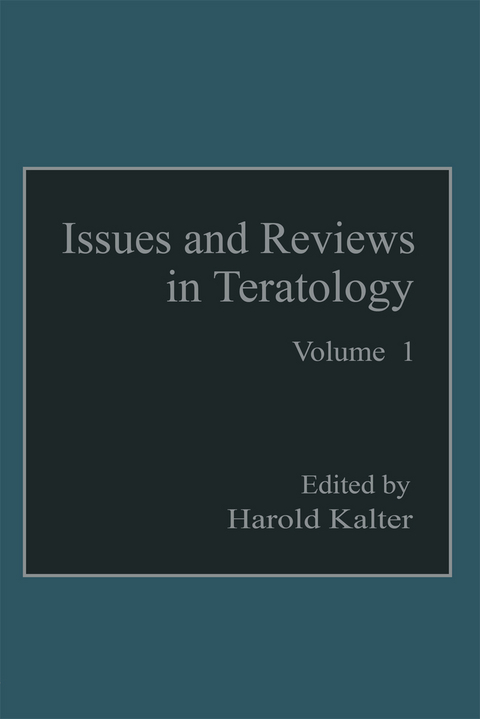
Issues and Reviews in Teratology
Springer-Verlag New York Inc.
978-1-4615-7313-5 (ISBN)
1. Problems in Human Teratology.- 1. Introductory Remarks.- 2. Advances in Knowledge and Technology during the Past 30 Years.- 3. Clinical Progress through Application of Practical Procedures.- 4. Present-Day Problems.- 5. Future Perspectives.- 6. Conclusion.- 7. Summary.- 2. Teratology: Spectrum of a Science.- 1. Ancient Records.- 2. Portents.- 3. Hybrids.- 4. Teratology and Superstition.- 5. Natural Philosophy.- 6. Anatomy and Pathology.- 7. Embryology and Experimental Teratology.- 8. Genetics.- 9. Surgery.- 10. Obstetrics.- 11. Law.- 12. Prevention.- References.- 3. Cytogenetics of Human Reproductive Wastage.- 1. History and Definition of Abortion.- 2. Historical Aspects of Cytogenetics.- 3. Frequency of Chromosome Anomalies in Miscarriages.- 4. Techniques of Study.- 5. Relative Frequency of Types of Chromosome Anomalies.- 6. Cystic Changes of the Chorionic Villi.- 7. Cytogenetic Studies of Stillbirth and Neonatal Death.- 8. Translocations in Miscarriages.- 9. Chromosome Anomalies and Recurrent Abortion.- 10. Etiology of Chromosome Anomalies.- 11. Sex Ratio.- 12. Significance of the Cytogenetic Findings in Pregnancy Wastage.- 13. The Future for Cytogenetic Studies of Abortuses.- References.- 4. Twenty Years of Study of the Etiology of Congenital Malformations in Finland.- 1. Introduction.- 2. The Study Population.- 3. The Finnish Register of Congenital Malformations.- 4. Incidence of Congenital Malformations.- 5. The Matched-Pair Register.- 6. Special Studies.- 7. Limitations and Pitfalls of Epidemiologic Studies.- 8. Concluding Remarks.- References.- 5. Genome and Chromosome Mutations: Balance between Appearance and Elimination.- 1. Introduction.- 2. Numerical Chromosome Anomalies or Genome Mutations.- 3. Chromosome Structural Rearrangements or Chromosome Mutations.- 4. Human Chromosome Heteromorphisms (Variants, Polymorphisms).- 5. Minor Deletions and Mutation.- 6. Chromosomal Mutations and Evolution.- 7. Population Genetics of Structural Chromosome Rearrangements.- 8. Conclusion.- References.- 6. Developmental Toxicity and Nonhuman Primates: Interspecies Comparisons.- 1. Introduction.- 2. Thalidomide.- 3. Fungicides.- 4. Cytotoxic Agents.- 5. X-Irradiation.- 6. Hyperthermia.- 7. Androgens and Progestins.- 8. Glucocorticoids.- 9. Summary.- 10. Experimental Protocols.- 11. Comparative Embryology.- 12. Conclusion.- References.- 7. Teratogenic Risk Assessment: Past, Present, and Future.- 1. Introduction.- 2. Present Testing Strategy: Tolerance Levels/Risk-Benefit Analysis and the Concept of “Thresholds”.- 3. The Past in Risk Assessment of Teratogens.- 4. New Concepts of Toxicity Which May Have Application in Risk Assessment of Potential Teratogens.- 5. Appropriate Present-Day Approaches to Teratogenic Risk Assessment.- 6. Summary and Conclusions.- References.- 8. Thalidomide and Embryonic Sensory Peripheral Neuropathy: An Appraisal of the Neuropathic Theory of Limb Reduction Defects.- 1. Introduction.- 2. Statement of the Neuropathic Theory of Limb Reduction Defects.- 3. Premises of the Theory.- 4. Analysis of the Premises and Supporting Arguments and Observations.- 5. Summary.- 6. Other Theories of the Mechanism of Thalidomide Teratogenicity.- References.- 9. Restorative Growth in Mammalian Embryos.- 1. Introduction.- 2. Embryologic Studies.- 3. Teratologic Studies.- 4. Conclusions and Discussion.- References.- 10. Functional Teratology of the Cardiovascular and Other Organ Systems.- 1. Introduction.- 2. Effects of the Pesticide Mirex on the Fetal Cardiovascular System—A Case Study.- 3. Functional Teratology of Other OrganSystems.- 4. Concluding Comments.- References.- 11. Searching for the Mechanism of Acetazolamide Teratogenesis.- 1. Acetazolamide Teratology.- 2. Carbonic Anhydrase.- 3. Carbonic Anhydrase Inhibition by Acetazolamide.- 4. Carbonic Anhydrase during Development.- 5. Studies of the Mechanism of Acetazolamide Teratogenesis.- 6. Recent Studies on the Teratogenic Mechanism of Acetazolamide.- 7. Comparative Studies in Rats, Rabbits, and Monkeys.- 8. Discussion.- References.
| Erscheint lt. Verlag | 5.11.2012 |
|---|---|
| Zusatzinfo | 31 Illustrations, black and white; XVII, 354 p. 31 illus. |
| Verlagsort | New York, NY |
| Sprache | englisch |
| Maße | 152 x 229 mm |
| Themenwelt | Sachbuch/Ratgeber ► Natur / Technik ► Naturführer |
| Medizin / Pharmazie ► Medizinische Fachgebiete ► Gynäkologie / Geburtshilfe | |
| Studium ► 2. Studienabschnitt (Klinik) ► Humangenetik | |
| Naturwissenschaften ► Biologie ► Genetik / Molekularbiologie | |
| ISBN-10 | 1-4615-7313-0 / 1461573130 |
| ISBN-13 | 978-1-4615-7313-5 / 9781461573135 |
| Zustand | Neuware |
| Haben Sie eine Frage zum Produkt? |
aus dem Bereich


